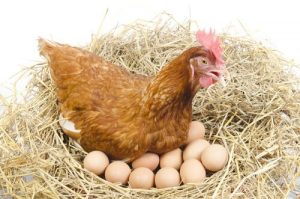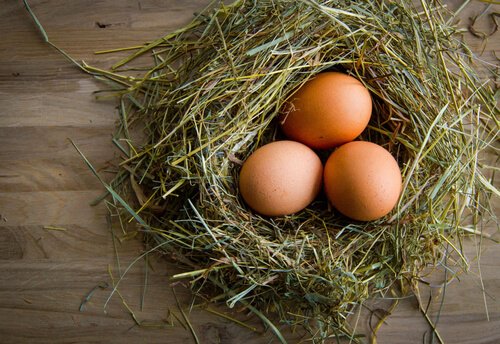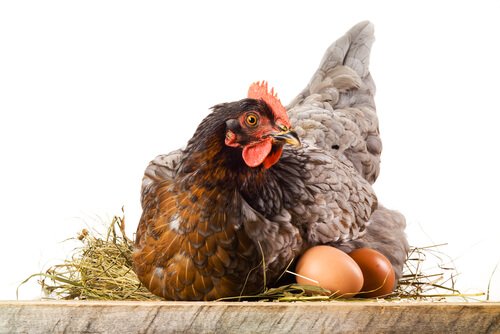Do Hens Lay Eggs Every Day?


Written and verified by the lawyer Francisco María García
There are a couple of variables that affect the number and frequency birds lay eggs. Some birds, such as thrushes, will wait for proper conditions to raise their chicks. For example, chiffchaffs only lay eggs once a year. So, you may be wondering: how long does it take hens to lay their eggs? How many eggs can they lay daily?
The History of Laying Hens
The answer is yes, hens in captivity lay eggs every day. However, laying eggs doesn’t dependent on the rooster’s presences. Instead, it depends on the hen’s hormonal cycle. Either way, the farm chicken you see today is basically the outcome of genetic selection throughout history.
9,000 years ago in Asia is when the story of hen and the egg began. The Gallus Bankiva laid its eggs once a year, in sets of 12. The idea of using eggs as food began to spread in Europe during the late nineteenth century, which led to a decrease in the diversity of this bird’s species.
In the poultry industry, the New Hampshire and Leghom hens are the most exploited due to their eggs and offspring. In the past hens would only lay 12 eggs once a year, now they lay approximately 300 annually.

What is An Egg?
So, the question is: why do hens in captivity lay eggs every day? Well, these females are born with around 4,000 follicles (or future ovules) in their left ovary. They begin to ovulate when they are between four and six months old.
A hen’s hormonal cycle lasts 10 weeks, and during each period, up to 10 ovules mature. The reason why hens in captivity lay eggs every 24 to 26 hours due to the cycles overlapping. This constant and complex internal process lasts for two years. Therefore, their first two years of life is when the hen is at its prime.
How Do Eggs Develop Inside of Hens?
When hens are exposed to light, it will cause hormone segregation that causes the follicles to release. This means that a hen’s organism is prepared to act before receiving the solar stimulus. Afterward, the follicle begins to mature in the yolk.
Each yolk contains a nutrient supply long enough for 10 days. It consists of glucose, water, fats, and proteins. If the ovum were to become fertilized, the yolk’s nutrients would be used for the chick’s development. It is worth pointing out that chicks live and develop inside the egg for 21 days.
The color of the yolk will depend on the quality of the hen’s feed. The yolk is surrounded by a clear, gelatinous substance (commonly referred to as an egg white) that protects the embryo.

After 25 hours, the yolk is ready to exit the ovary. The oviduct, which is about 60 centimeters long, begins forming three layers of egg white through the release of proteins. Once it’s in the uterus, the shell will take about 14 hours to form.
This shell is composed of calcium carbonate and has pores for air. Finally, the shell’s pores are coated before leaving the hen’s body, to prevent bacteria entry. The pigmentation of the minerals that cover the shell is what give the egg its color.
The Poultry Industry: Why Hens Lay Eggs Every Day
The formation of each egg is an extraordinary and complex process. It would be impossible for a wild hen to lay more than one egg daily. Hens don’t lay so many eggs naturally, as they would in industrial captivity.
The poultry industry installs certain specific devices in hen houses that force the hen’s organisms to lay eggs uncontrollably.
Hens that are captive are kept under lights 24 hours a day. By doing so, their organisms believe that it is always daytime and constantly release the follicles necessary to lay eggs.
Plus, since they don’t have their own nests, hens cannot be aware of their eggs. This makes them feel the need to lay one after another. In addition to how unethical this is, it’s worth asking yourself how good the quality of such a product can honestly be.
There are a couple of variables that affect the number and frequency birds lay eggs. Some birds, such as thrushes, will wait for proper conditions to raise their chicks. For example, chiffchaffs only lay eggs once a year. So, you may be wondering: how long does it take hens to lay their eggs? How many eggs can they lay daily?
The History of Laying Hens
The answer is yes, hens in captivity lay eggs every day. However, laying eggs doesn’t dependent on the rooster’s presences. Instead, it depends on the hen’s hormonal cycle. Either way, the farm chicken you see today is basically the outcome of genetic selection throughout history.
9,000 years ago in Asia is when the story of hen and the egg began. The Gallus Bankiva laid its eggs once a year, in sets of 12. The idea of using eggs as food began to spread in Europe during the late nineteenth century, which led to a decrease in the diversity of this bird’s species.
In the poultry industry, the New Hampshire and Leghom hens are the most exploited due to their eggs and offspring. In the past hens would only lay 12 eggs once a year, now they lay approximately 300 annually.

What is An Egg?
So, the question is: why do hens in captivity lay eggs every day? Well, these females are born with around 4,000 follicles (or future ovules) in their left ovary. They begin to ovulate when they are between four and six months old.
A hen’s hormonal cycle lasts 10 weeks, and during each period, up to 10 ovules mature. The reason why hens in captivity lay eggs every 24 to 26 hours due to the cycles overlapping. This constant and complex internal process lasts for two years. Therefore, their first two years of life is when the hen is at its prime.
How Do Eggs Develop Inside of Hens?
When hens are exposed to light, it will cause hormone segregation that causes the follicles to release. This means that a hen’s organism is prepared to act before receiving the solar stimulus. Afterward, the follicle begins to mature in the yolk.
Each yolk contains a nutrient supply long enough for 10 days. It consists of glucose, water, fats, and proteins. If the ovum were to become fertilized, the yolk’s nutrients would be used for the chick’s development. It is worth pointing out that chicks live and develop inside the egg for 21 days.
The color of the yolk will depend on the quality of the hen’s feed. The yolk is surrounded by a clear, gelatinous substance (commonly referred to as an egg white) that protects the embryo.

After 25 hours, the yolk is ready to exit the ovary. The oviduct, which is about 60 centimeters long, begins forming three layers of egg white through the release of proteins. Once it’s in the uterus, the shell will take about 14 hours to form.
This shell is composed of calcium carbonate and has pores for air. Finally, the shell’s pores are coated before leaving the hen’s body, to prevent bacteria entry. The pigmentation of the minerals that cover the shell is what give the egg its color.
The Poultry Industry: Why Hens Lay Eggs Every Day
The formation of each egg is an extraordinary and complex process. It would be impossible for a wild hen to lay more than one egg daily. Hens don’t lay so many eggs naturally, as they would in industrial captivity.
The poultry industry installs certain specific devices in hen houses that force the hen’s organisms to lay eggs uncontrollably.
Hens that are captive are kept under lights 24 hours a day. By doing so, their organisms believe that it is always daytime and constantly release the follicles necessary to lay eggs.
Plus, since they don’t have their own nests, hens cannot be aware of their eggs. This makes them feel the need to lay one after another. In addition to how unethical this is, it’s worth asking yourself how good the quality of such a product can honestly be.
All cited sources were thoroughly reviewed by our team to ensure their quality, reliability, currency, and validity. The bibliography of this article was considered reliable and of academic or scientific accuracy.
- Elson, H. & Vale, M. (2011). Housing and husbandry of laying hens: past, present and future. Lohmann Information, 46(2), 16-24. Disponible en: https://www.cabdirect.org/cabdirect/abstract/20123040964
- García, R., Berrocal, J., Moreno, L., & Ferrón, G. (2009). Producción ecológica de gallinas ponedoras. Junta de Andalucía. Disponible en: https://www.juntadeandalucia.es/export/drupaljda/GALLINAS_PONEDORAS_ok.pdf
- Lin, H., Mertens, K., Kemps, B., et al. (2004). New approach of testing the effect of heat stress on eggshell quality: mechanical and material properties of eggshell and membrane. British Poultry Science, 45(4), 476-482. Disponible en: https://www.tandfonline.com/doi/abs/10.1080/00071660400001173?journalCode=cbps20
- Sah, N., & Mishra, B. (2018). Regulation of egg formation in the oviduct of laying hen. World’s Poultry Science Journal, 74(3), 509-522. Disponible en: https://www.cambridge.org/core/journals/world-s-poultry-science-journal/article/abs/regulation-of-egg-formation-in-the-oviduct-of-laying-hen/9F0589E61941E7F50ECB1347B918781A
This text is provided for informational purposes only and does not replace consultation with a professional. If in doubt, consult your specialist.








